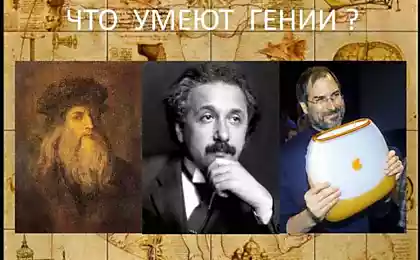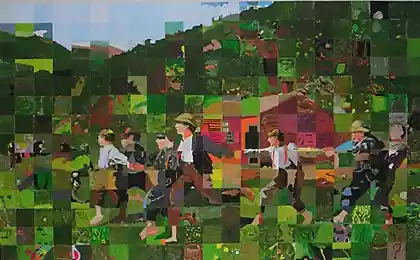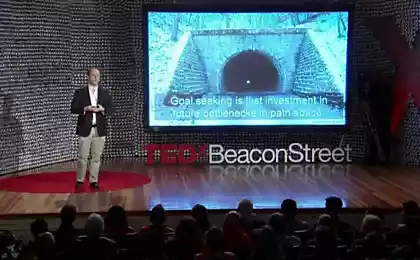460
Intelligence is not the main thing: How geniuses think
Marilyn vos savant, world record IQ of 228 items — not contributed anything to science nor art, but merely leads a column of questions and answers in Parade magazine.
The most that neither is a mediocre physics have much higher IQs than Nobel prize winner Richard Feynman, whom many consider the last great American genius (his IQ was "only" a decent 122 points).
Researchers have been trying to establish the relationship between intellect and genius, but intelligence is not enough. He published a book "Cracking creativity" American expert on creativity Michael Michalko with examples from the works of famous thinkers and practical exercises in search of original ideas. Published some chapters.

To see what others do not see
Leonardo da Vinci believed that to gain knowledge about the form of the problem, one must first understand how to convert it as different ways. He believed that the first approach to the problem, by definition, is too prejudiced, because this is the usual way to see things.
The master looked at the problem first from one angle of view, and then under several others. Each time, his understanding became deeper, and he began to see the point. This mental strategyLeonardo called saper vedere, that is "know how look".
Genius often manifests itself in the fact, to find a new approach. Theory of relativity — in fact, the description of the interactions of different perspectives. Freud "rephrase" the problem in order to change its meaning, is placed not in the context in which it is used to perceive. For example, by defining the unconscious as "infantile" part of the mind, Freud helped patients to change the way of thinking and reactions to their own behavior.
One of the many ways our mind tries to make life easier, — making a good first impression of the situation. As first impressions about people, our runaway views on the problems and situations are usually narrow and prejudice. We only see what used to see, and stereotypical thinking interferes with clear consideration of the objectives and work of the imagination.
While there is no doubt the correct approach, therefore, we did not understand what is happening. Having established one point of view, we cut off everything else. We have ideas of some sort, but only they, and not any other. Imagine a paralyzed man who invented the wheelchair, determined their task with the phrase "something to occupy the time while I lie in bed?", not the idea of "How to get out of bed and move around?"
You need to be free and learn to see what you are looking for
If you look closely to the wheels of the train? They have flanges, that is, the tabs inside that prevent the train slipping off the rails. Initially, these flanges in the carriages was not. Instead, they were equipped with rail tracks. The issue of railway safety was: "How to make the path safer for the passage of wagons?"
Hundreds of thousands of miles of railroad tracks, was released with unnecessary steel ledges. Only after the question changed and became to be different: "What you need to do the wheels so they are more firmly in contact with the canvas?" — invented the wheel flanges.
Let's start with what is generally useful to formulate problems in a certain way. Write down the tasks that lie before you, in the form of a question. Use the phrase "in What ways can I..." to beginning of sentence: this is called the invitation template and helps not to get stuck on the wording of the problem, allowing for a single interpretation. For example, cross out of the gobbledygook, the following six letters to get a common word.
W T V E S O R T AND S B T U K S IN
If you formulate the problem with "How to cross out six letters to an existing word?", to solve this exercise will not be easy. However, if you put the question: "What are some ways I can cross out six letters to an existing word?" you may be inspired, you will think about a whole range of alternative solutions, including about the omission of the letters that compose the words "six letters", to get the word to CREATE.
Little Einstein had a favorite uncle Jakob, who taught him mathematics, changing the appearance of tasks. For example, from algebra he was doing a scavenger hunt on a small mysterious pet (X). As a result of winning (if the problem was solved) albert "caught" the beast and called his real name.
Changing the content of the tasks and turning math into a game, Jacob was teaching the boy to approach the problem as a game and not as work. Subsequently, Einstein focused on his classes with the same intensity that most reserved for games and Hobbies.
Consider a sequence of letters FFMMTT. You may define it as three pairs of letters. If you offer a line KLMMNOTUV, you most likely consider it to be three triples of letters. In each case, the letters MM are perceived differently — as members of the same or different groups. If you write only the letters MM, you will not have any reason not to consider them as a few letters. This information context influences the decision and sometimes convinces us to abandon the original version in favor of some other.
The more often you will be able to put the question another way, the more likely it is that an understanding of the problems will change and will gain depth. When Einstein solved any problem, he thought it necessary to restate its maximum number of ways.
One question, what would he do if he found out about a huge comet that in an hour will hit the Earth and completely destroy it, Einstein replied that he would spend 55 minutes to find out the problem and five minutes on the solution.
The claims of Freud about the subconscious seem to be a great scientific discovery, but in fact this is just a General introduction to the topic in a different way. Copernicus or Darwin discovered not a new theory, but a wonderful new point of view. Before embarking on a brainstorming task, reframe it at least five or ten ways to explore with different angles. It's important to focus not so much on the right as on the alternative definition of the problem. Sooner or later you will find an acceptable solution.
To think as others think
Every time we try to do something and fail, in the end do something else. No matter how obvious this statement may seem, it is the first principle of creative accident — so-called Serendipity. You can ask why I didn't get what we wanted, and it's perfectly reasonable and expected. But the creative accident provokes you to ask another question: what did we do? New, unexpected answer to this question is, in fact, the act of creation. It's not luck, but creative idea of the highest order.
Serendipity — Serendipity; the ability to make profound conclusions from random observations, to find what was looking for. In addition, this term refers to the fact of unexpected discoveries, as well as psychological state at this moment.
The discovery of the electromagnetic laws have been creative coincidence. The relationship between electricity and magnetism was first seen in 1820, Hans Oersted — ironically, at a public lecture where he showed a "well known fact" that electricity and magnetism are completely independent phenomena. The experiment that day failed, as the electric current gave a magnetic effect. Oersted was observant enough to notice the effect; honest enough to recognize it, and diligent enough to study and publish it. Maxwell used these experiments to the distribution of the Newtonian modeling methods and mathematical analysis in the visible mechanical world to the invisible world of electricity and magnetism and deduced some laws (they now bear his name), which opened the door to the modern world of electricity and electronics.

Even when we try consciously and rationally to do something, sometimes committed what was intended. John Wesley Hyatt, a printer and a mechanic from Albany, have worked long and hard on creating material for billiard balls, as ivory has become a rarity. In the end, however, he invented celluloid, the first commercially successful plastic. B. F. Skinner advised to everyone who is working on his task, noticed something interesting, leaving the original idea and explore it is something.
In fact, he elevated this idea to the rank of a first principle of scientific methodology. Did William Shockley and multidisciplinary team of Bell lab. Initially, this team was created to work on a MOS transistor, as a result, they have developed a contact planar transistor, and simultaneously created a new science — physics of semiconductors. These achievements are the result still led to the creation of the MOS transistor and then to integrated circuits, and new breakthroughs in the field of electronics and computers. William Shockley described the process as "creative failure methodology".
Before you begin brainstorming, reframe the task at least five or ten ways
Richard Feynman had an interesting practical test that he estimated a new idea: does it have something not related to the original problem? That is: "Can you explain something that you are not going to explain?" and "whether you have Opened something that was not going to open?"
In 1938, Roy Plunkett, twenty-seven, had intended to come up with a new refrigerant. Instead, he turned a ball of white waxy material that conducted heat and did not stick to surfaces. Fascinated by this strange story, he refused from the initial idea of the study and began experimenting with a new substance that later became known as Teflon.
In principle, the unexpected event that provokes unscheduled invention, differs little from a suddenly broken car, which has to spend the night in a strange city interesting; from the book sent in error, but which we really liked; from the closing of the restaurant have been prompted to try a different cuisine. But in search of ideas and creative solutions, many do not pay attention to unexpected and, therefore, lose the opportunity to convert his chance into a creative opportunity. You need to be free and learn to see what you are looking for.
In 1839, Charles Goodyear was looking for ways to facilitate the work with the tires and accidentally spilled the liquid, which is hardened, but has not lost its qualities. Pushing his thought in this unpredictable direction, he invented the vulcanization process; focusing on "interesting" aspects of the idea, opened it potential.
Alexander Fleming was not the first of the doctors in the study of dead bacteria noticed on culture, is not placed in proper conditions, the mold is formed. Less gifted experts have cast aside this seemingly insignificant fact, but Fleming noted it as curious and assumed the existence of a potential in it. This observation has led to the emergence of penicillin that saved millions of lives. Thomas Edison, reflecting on how better to implement the idea of a carbon filament, was playing with a piece of the putty, rolling it in his hands and twisting; when he looked at his hands, the answer came by itself: you need to twist the thread as the rope.
Usually we use intelligence to support and rationalize their emotions and prejudices about a specific idea or subject. For example, you are going to buy a sweater for $ 125 and a stationary device for $ 15. The seller of the office says the exact same device is offered for sale at another store the same network, a 20-minute walk, and there is $ 10. Will you go there? Most answer that Yes.
The other group is given the same question, but this time the sweater costs $ 15, and a stationery device is $ 125, and in another store it costs 120. Of those who were offered this version of events, the majority refused to March to another store. Note that in both cases, purchases are made on the same amount and choice in both cases is, whether to go 20 minutes to save five dollars.
But, apparently, the respondents evaluate the savings relative to the price of office equipment. In relative terms, as we have less strength to resist the temptation to save 33% (reducing rates from 15 to 10 dollars), less than five percent (reduced from 125 to 120$).
Instead of supporting his intellect, emotions and prejudices, it is necessary to use it to analyze the subject before the emotions and prejudices will play a role. If this is done, the said respondents, they would have immediately realized that the choice in both cases is identical: whether to go 20 minutes to save five dollars. To apply intelligence to the analysis of an object, you need to want to do it.
See also:
Do not think that running away from bad closer to good...
Trash consciousness: the mud dries and scrub it becomes more difficult
P. S. And remember, only by changing their consumption — together we change the world! ©
Join us in Facebook , Vkontakte, Odnoklassniki
Source: cameralabs.org/9999-vzlom-kreativa-kak-myslyat-genii-i-pochemu-intellekt-ne-glavnoe
The most that neither is a mediocre physics have much higher IQs than Nobel prize winner Richard Feynman, whom many consider the last great American genius (his IQ was "only" a decent 122 points).
Researchers have been trying to establish the relationship between intellect and genius, but intelligence is not enough. He published a book "Cracking creativity" American expert on creativity Michael Michalko with examples from the works of famous thinkers and practical exercises in search of original ideas. Published some chapters.

To see what others do not see
Leonardo da Vinci believed that to gain knowledge about the form of the problem, one must first understand how to convert it as different ways. He believed that the first approach to the problem, by definition, is too prejudiced, because this is the usual way to see things.
The master looked at the problem first from one angle of view, and then under several others. Each time, his understanding became deeper, and he began to see the point. This mental strategyLeonardo called saper vedere, that is "know how look".
Genius often manifests itself in the fact, to find a new approach. Theory of relativity — in fact, the description of the interactions of different perspectives. Freud "rephrase" the problem in order to change its meaning, is placed not in the context in which it is used to perceive. For example, by defining the unconscious as "infantile" part of the mind, Freud helped patients to change the way of thinking and reactions to their own behavior.
One of the many ways our mind tries to make life easier, — making a good first impression of the situation. As first impressions about people, our runaway views on the problems and situations are usually narrow and prejudice. We only see what used to see, and stereotypical thinking interferes with clear consideration of the objectives and work of the imagination.
While there is no doubt the correct approach, therefore, we did not understand what is happening. Having established one point of view, we cut off everything else. We have ideas of some sort, but only they, and not any other. Imagine a paralyzed man who invented the wheelchair, determined their task with the phrase "something to occupy the time while I lie in bed?", not the idea of "How to get out of bed and move around?"
You need to be free and learn to see what you are looking for
If you look closely to the wheels of the train? They have flanges, that is, the tabs inside that prevent the train slipping off the rails. Initially, these flanges in the carriages was not. Instead, they were equipped with rail tracks. The issue of railway safety was: "How to make the path safer for the passage of wagons?"
Hundreds of thousands of miles of railroad tracks, was released with unnecessary steel ledges. Only after the question changed and became to be different: "What you need to do the wheels so they are more firmly in contact with the canvas?" — invented the wheel flanges.
Let's start with what is generally useful to formulate problems in a certain way. Write down the tasks that lie before you, in the form of a question. Use the phrase "in What ways can I..." to beginning of sentence: this is called the invitation template and helps not to get stuck on the wording of the problem, allowing for a single interpretation. For example, cross out of the gobbledygook, the following six letters to get a common word.
W T V E S O R T AND S B T U K S IN
If you formulate the problem with "How to cross out six letters to an existing word?", to solve this exercise will not be easy. However, if you put the question: "What are some ways I can cross out six letters to an existing word?" you may be inspired, you will think about a whole range of alternative solutions, including about the omission of the letters that compose the words "six letters", to get the word to CREATE.
Little Einstein had a favorite uncle Jakob, who taught him mathematics, changing the appearance of tasks. For example, from algebra he was doing a scavenger hunt on a small mysterious pet (X). As a result of winning (if the problem was solved) albert "caught" the beast and called his real name.
Changing the content of the tasks and turning math into a game, Jacob was teaching the boy to approach the problem as a game and not as work. Subsequently, Einstein focused on his classes with the same intensity that most reserved for games and Hobbies.
Consider a sequence of letters FFMMTT. You may define it as three pairs of letters. If you offer a line KLMMNOTUV, you most likely consider it to be three triples of letters. In each case, the letters MM are perceived differently — as members of the same or different groups. If you write only the letters MM, you will not have any reason not to consider them as a few letters. This information context influences the decision and sometimes convinces us to abandon the original version in favor of some other.
The more often you will be able to put the question another way, the more likely it is that an understanding of the problems will change and will gain depth. When Einstein solved any problem, he thought it necessary to restate its maximum number of ways.
One question, what would he do if he found out about a huge comet that in an hour will hit the Earth and completely destroy it, Einstein replied that he would spend 55 minutes to find out the problem and five minutes on the solution.
The claims of Freud about the subconscious seem to be a great scientific discovery, but in fact this is just a General introduction to the topic in a different way. Copernicus or Darwin discovered not a new theory, but a wonderful new point of view. Before embarking on a brainstorming task, reframe it at least five or ten ways to explore with different angles. It's important to focus not so much on the right as on the alternative definition of the problem. Sooner or later you will find an acceptable solution.
To think as others think
Every time we try to do something and fail, in the end do something else. No matter how obvious this statement may seem, it is the first principle of creative accident — so-called Serendipity. You can ask why I didn't get what we wanted, and it's perfectly reasonable and expected. But the creative accident provokes you to ask another question: what did we do? New, unexpected answer to this question is, in fact, the act of creation. It's not luck, but creative idea of the highest order.
Serendipity — Serendipity; the ability to make profound conclusions from random observations, to find what was looking for. In addition, this term refers to the fact of unexpected discoveries, as well as psychological state at this moment.
The discovery of the electromagnetic laws have been creative coincidence. The relationship between electricity and magnetism was first seen in 1820, Hans Oersted — ironically, at a public lecture where he showed a "well known fact" that electricity and magnetism are completely independent phenomena. The experiment that day failed, as the electric current gave a magnetic effect. Oersted was observant enough to notice the effect; honest enough to recognize it, and diligent enough to study and publish it. Maxwell used these experiments to the distribution of the Newtonian modeling methods and mathematical analysis in the visible mechanical world to the invisible world of electricity and magnetism and deduced some laws (they now bear his name), which opened the door to the modern world of electricity and electronics.

Even when we try consciously and rationally to do something, sometimes committed what was intended. John Wesley Hyatt, a printer and a mechanic from Albany, have worked long and hard on creating material for billiard balls, as ivory has become a rarity. In the end, however, he invented celluloid, the first commercially successful plastic. B. F. Skinner advised to everyone who is working on his task, noticed something interesting, leaving the original idea and explore it is something.
In fact, he elevated this idea to the rank of a first principle of scientific methodology. Did William Shockley and multidisciplinary team of Bell lab. Initially, this team was created to work on a MOS transistor, as a result, they have developed a contact planar transistor, and simultaneously created a new science — physics of semiconductors. These achievements are the result still led to the creation of the MOS transistor and then to integrated circuits, and new breakthroughs in the field of electronics and computers. William Shockley described the process as "creative failure methodology".
Before you begin brainstorming, reframe the task at least five or ten ways
Richard Feynman had an interesting practical test that he estimated a new idea: does it have something not related to the original problem? That is: "Can you explain something that you are not going to explain?" and "whether you have Opened something that was not going to open?"
In 1938, Roy Plunkett, twenty-seven, had intended to come up with a new refrigerant. Instead, he turned a ball of white waxy material that conducted heat and did not stick to surfaces. Fascinated by this strange story, he refused from the initial idea of the study and began experimenting with a new substance that later became known as Teflon.
In principle, the unexpected event that provokes unscheduled invention, differs little from a suddenly broken car, which has to spend the night in a strange city interesting; from the book sent in error, but which we really liked; from the closing of the restaurant have been prompted to try a different cuisine. But in search of ideas and creative solutions, many do not pay attention to unexpected and, therefore, lose the opportunity to convert his chance into a creative opportunity. You need to be free and learn to see what you are looking for.
In 1839, Charles Goodyear was looking for ways to facilitate the work with the tires and accidentally spilled the liquid, which is hardened, but has not lost its qualities. Pushing his thought in this unpredictable direction, he invented the vulcanization process; focusing on "interesting" aspects of the idea, opened it potential.
Alexander Fleming was not the first of the doctors in the study of dead bacteria noticed on culture, is not placed in proper conditions, the mold is formed. Less gifted experts have cast aside this seemingly insignificant fact, but Fleming noted it as curious and assumed the existence of a potential in it. This observation has led to the emergence of penicillin that saved millions of lives. Thomas Edison, reflecting on how better to implement the idea of a carbon filament, was playing with a piece of the putty, rolling it in his hands and twisting; when he looked at his hands, the answer came by itself: you need to twist the thread as the rope.
Usually we use intelligence to support and rationalize their emotions and prejudices about a specific idea or subject. For example, you are going to buy a sweater for $ 125 and a stationary device for $ 15. The seller of the office says the exact same device is offered for sale at another store the same network, a 20-minute walk, and there is $ 10. Will you go there? Most answer that Yes.
The other group is given the same question, but this time the sweater costs $ 15, and a stationery device is $ 125, and in another store it costs 120. Of those who were offered this version of events, the majority refused to March to another store. Note that in both cases, purchases are made on the same amount and choice in both cases is, whether to go 20 minutes to save five dollars.
But, apparently, the respondents evaluate the savings relative to the price of office equipment. In relative terms, as we have less strength to resist the temptation to save 33% (reducing rates from 15 to 10 dollars), less than five percent (reduced from 125 to 120$).
Instead of supporting his intellect, emotions and prejudices, it is necessary to use it to analyze the subject before the emotions and prejudices will play a role. If this is done, the said respondents, they would have immediately realized that the choice in both cases is identical: whether to go 20 minutes to save five dollars. To apply intelligence to the analysis of an object, you need to want to do it.
See also:
Do not think that running away from bad closer to good...
Trash consciousness: the mud dries and scrub it becomes more difficult
P. S. And remember, only by changing their consumption — together we change the world! ©
Join us in Facebook , Vkontakte, Odnoklassniki
Source: cameralabs.org/9999-vzlom-kreativa-kak-myslyat-genii-i-pochemu-intellekt-ne-glavnoe























